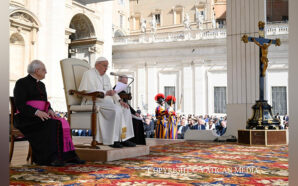This article was originally published in the March edition of the Melbourne Catholic Magazine.
When you think of women from the New Testament, most likely the names that come to mind are Mary, mother of Jesus, Mary Magdalene, Mary the sister of Martha, Martha herself and maybe Elizabeth or Anna. But for every Mary, there’s twice as many women who appear in the New Testament whose stories are often overlooked but are crucial in the development of the early Church.
Priscilla
(Acts 18:2–3, 26; Rom 16:3)
An educated woman from Rome, Priscilla had a relatively high social standing. When Jewish people were expelled from their homes in Rome by Emperor Claudius in the year 49, she emigrated to Corinth with her husband Aquila where she met Paul. Paul lived with Priscilla and Aquila for approximately 18 months. She and Aquila were tentmakers, like Paul. Together, the couple became the earliest known Christian missionaries in the first century. In Romans 16:3–4, Paul sends his greetings to Priscilla and Aquila and proclaims that both of them ‘risked their necks’ to save his life. Both Priscilla and her husband are listed as insightful teachers of the gospel and credited with instructing Apollos, a major evangelist of the first century in Corinth and Ephesus, and explaining to him ‘the way of God more accurately’ (Acts 18:26). Priscilla was one of the earliest known Christian converts from Rome and some believe she is the anonymous author of the Epistle to the Hebrews
Lydia
(Acts 16:13–15, 40)
Lydia was a Macedonian woman who owned a purple-dye firm in Thyatira, in modern day Turkey. After hearing Paul speak outside the gates of Philippi, Lydia welcomed him into the city and into her home. Lydia is considered the first European Christian convert. In an environment where women were not considered equal to men, it’s noteworthy that Lydia was able to invite foreign men to stay at her home without permission. This indicates she was probably a wealthy widow. Lydia was a homeowner with social standing and influence in the city. The community that grew up around her home became one of the strongest in the early Church. Today, the Church regards her as ‘patroness of dyers’.
Phoebe
(Rom 16:1–2)
In Rome, before there was Paul, there was Phoebe. She was Paul’s ambassador and most likely was the person entrusted with taking Paul’s epistle to Rome long before he was able to get there himself. Paul calls Phoebe a sister, deacon and ‘benefactor to many and to me as well’. It’s clear she possessed a high social standing with considerable material wealth to engage in her role as benefactor. Paul acknowledges that in comparison to her, he would normally have had a relatively subordinate social position. Much more than a helper, Phoebe appears to have been essential to Paul’s plan not only for the Roman mission but also for his planned mission to Spain, then considered the ends of the earth. Phoebe’s social standing would have allowed her to undertake a journey to Rome with her own agenda and her own means to carry it out. When Paul writes to the Romans, he indicates just how much he depended on Phoebe: ‘Receive her in the Lord in a manner worthy of the holy ones, and help her in whatever she may need from you’ (Rom 16:1–2).
Junia
(Romans 16:7)
We don’t know a lot about Junia, except that she was an important person in the early Church. Paul not only called her his fellow apostle, but said she was ‘of note among the apostles’. Alongside her husband Andronicus, she was imprisoned with Paul for her faith. Paul admits they were Christians even before he was, saying they ‘were in Christ before me’. In scripture, Junia is referred to in her own right, not simply as an attachment to her husband, implying she had earned her position in society, rather than her status being simply an extension of her husband’s. Given the low social status of women in Greco-Roman society, she is one of several women mentioned as Paul closes his Letter to the Romans. This is a sign of the counter-cultural ‘newness’ of Christianity.
Eunice and Lois
(2 Tim 1:5; 3:15)
We’re counting this pair as a single entry. Eunice was Timothy’s mother, Lois was Timothy’s grandmother. This pair of women were responsible for the spiritual formation of one of the greatest evangelists of the first century. We cannot be sure who wrote 2 Timothy, as it is one of several letters attributed to Paul by his immediate followers after he died. But they all depend upon historical reminiscences. The epistle to Timothy is most famous for the author instructing his protégé not to let his own youth and inexperience become a mental barrier to becoming an effective pastor and evangelist. In the epistle, the author reminds Timothy that ever since he was a little boy, he had learned scripture from his mother Eunice and his grandmother Lois, suggesting firstly that these were strong women of God, but secondly indicating that the spiritual formation of young people often fell to the females in the household. It was their instruction, Paul believed, that prepared the way for people like Timothy to become converts to Christianity.
With thanks to Melbourne Catholic Magazine and the Archdiocese of Melbourne, where this article originally appeared.








